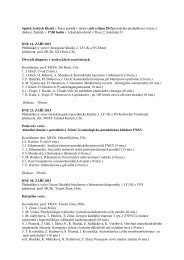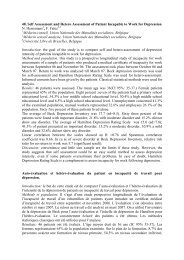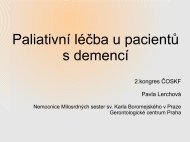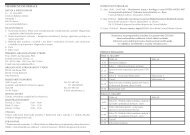ABSTRACTS â ORAL PRESENTATIONS - AMCA, spol. s r.o.
ABSTRACTS â ORAL PRESENTATIONS - AMCA, spol. s r.o.
ABSTRACTS â ORAL PRESENTATIONS - AMCA, spol. s r.o.
Create successful ePaper yourself
Turn your PDF publications into a flip-book with our unique Google optimized e-Paper software.
P66. IMPAIRED EXPRESSION OF CD154 IN THE CD4+ T CELLS IN CVID PATIENTS IN<br />
RESPONSE TO DIFFERENT STIMULI<br />
Olga Ticha, Marcela Vlkova<br />
Department of Clinical Immunology and Allergology, Faculty of Medicine, Masaryk<br />
University and St Anne’s University Hospital, Brno, Czech Republic; olga.ticha@fnusa.cz<br />
Patients with common variable deficiency (CVID) is heterogeneous group of disorders<br />
characteristic with impairment in specific antibody production and decreased levels<br />
of some or all immunoglobulin isotypes in serum. Underlying genetic defects are not<br />
yet well defined. Apart from defects in B-cell function one of possible mechanisms<br />
could be failure in T cell - B cell activation and interaction. The basic for production of<br />
immunoglobulin is interaction between costimulatory molecule CD154 (CD40L) on the<br />
CD4+ T cells and molecule CD40 on the B cells. CD40L is expressed on the surface of<br />
helper T cells after activation by antigen and costimulators. CD40L on the activated T<br />
helper cell then binds to CD40 on antigen activated B cells and initiates B cell proliferation<br />
and differentiation and production of immunoglobulins.<br />
We studied expression levels of molecules CD69 and CD154 (CD40L) on surface of<br />
CD3+8- lymphocytes of CVID patients in response to stimulation with ionomycine (IM)<br />
and phorbol myristate acetate (PMA) and on surface of CD3+4+ lymphocytes in response<br />
to stimulation with anti-CD3 and anti-CD28 monoclonal antibodies in CVID patients<br />
compare to group of healthy controls. Isolated peripheral blood mononuclear cells were<br />
used in our experiment.<br />
After 4 hour stimulation with IM and PMA the percentage of CD3+CD8- lymphocytes<br />
which expressed costimulatory molecule CD154 on their surface was comparable in<br />
both groups. But statistically significant difference in percentage of activated CD3+8-<br />
lymphocytes expressing CD69 in both groups was found.<br />
On the contrary CVID patients in our cohort show statistically significant decrease in<br />
level of activation of CD3+CD4+ lymphocytes and decreased percentage of CD3+8+<br />
expressing costimulatory molecule CD154 on their surface after stimulation with anti-<br />
CD3 together with anti–CD28 monoclonal antibody after 24 hours.<br />
We identified group of patients with low percentage of CD3+4+ lymphocytes expressing<br />
molecule CD154 (< 20% from CD3+4+) after anti-CD3 and anti-CD28 antibodies which<br />
are divided in to two different subgroups based on expression of CD154 after stimulation<br />
with IM and PMA - with normal or decreased levels compare to controls although all of<br />
them have decreased percentage of CD3+8-CD69+ lymphocytes. It is possible that this<br />
is caused by different underlying defect in signaling in the upper levels of activation<br />
pathway.<br />
Through the fact that defect of molecule CD154 is not described as a fundamental<br />
underlying cause for impaired antibody production in CVID patients our results confirm<br />
previously published findings showing that for some patients decreased expression<br />
or activation of this molecule after stimulation could be crucial. We denoted concrete<br />
patients whose molecules in activation signaling pathways should be studied closely for<br />
phosphorylation and expression levels.<br />
Analytical Cytometry VII 167








